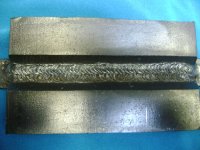gwdixon
Elite Member
It is called "stick" welding for multiple reasons, not just because the rods look like sticks.
3/32" 6011 is recommended to run 40A - 85A. Too hot and a stuck rod will fry.
Try this with 6011 as part of your practice:
Gently and quickly scrape the rod across the metal. (Some say "like a match" but you don't need to press so hard.) Just enough to get a spark. Do it again and again to get the feel of how to start a spark.
After you can make a spark each time, stop the scrape at the time of the spark and lift the rod just a bit off of the metal. Don't mind if the arc goes out the first few times you try it. Soon you'll be able to strike an arc and keep it going for a little while.
To keep from sticking, keep it a little away from the metal. You'll likely "long arc" it at first and metal BBs will fly and flashing will happen. Just shorten the distance to the metal at that point.
Remember, you are just practicing and burning up rod is part of the process.
3/32" 6011 is recommended to run 40A - 85A. Too hot and a stuck rod will fry.
Try this with 6011 as part of your practice:
Gently and quickly scrape the rod across the metal. (Some say "like a match" but you don't need to press so hard.) Just enough to get a spark. Do it again and again to get the feel of how to start a spark.
After you can make a spark each time, stop the scrape at the time of the spark and lift the rod just a bit off of the metal. Don't mind if the arc goes out the first few times you try it. Soon you'll be able to strike an arc and keep it going for a little while.
To keep from sticking, keep it a little away from the metal. You'll likely "long arc" it at first and metal BBs will fly and flashing will happen. Just shorten the distance to the metal at that point.
Remember, you are just practicing and burning up rod is part of the process.

